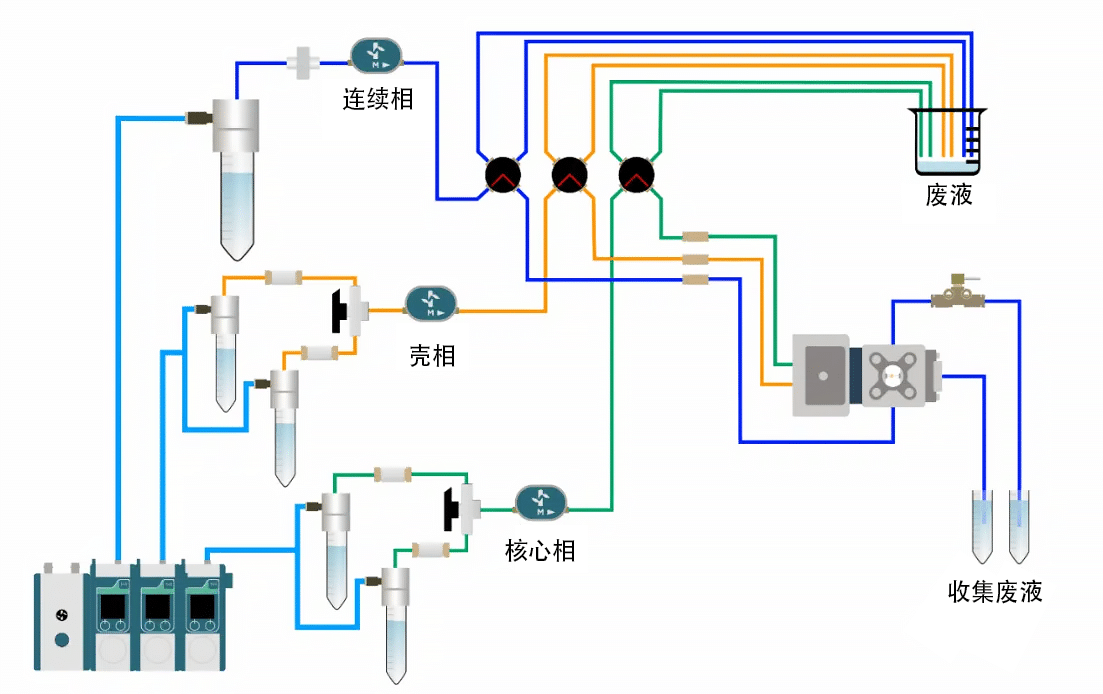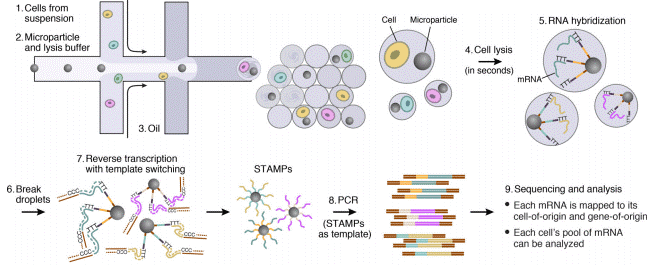Fortschrittliche Lösungen für die Tröpfchenproduktion
Tröpfchen-Plattformen
Verkapselungsplattform für FACS
Secoyas Zellverkapselungsplattform für FACS nutzt Flusskontrollgeräte von Fluigent und Emulsionstechnologie von Secoya. Das System ermöglicht die Hochdurchsatzverkapselung komplexer und einzelner Zellen in hochmonodispersen Doppelemulsionströpfchen (<90 µm), die für weitere Analysen geeignet sind.
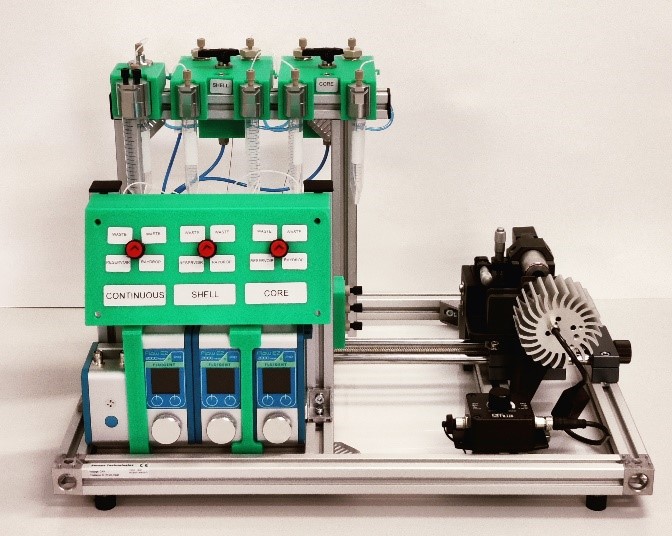
Dieses schnelle und einfache System ermöglicht die Verkapselung von Zellen in einem wässrigen Kern (z. B. Medium, PBS) und einer Ölemulsion (z. B. HFE 7500), die als leistungsfähiges Werkzeug für biochemische und zelluläre Assays dient. Die Plattform ermöglicht die Isolierung jeder Zelle in Mikroreaktoren, die Hervorhebung ihrer Eigenschaften und die Konzentration der Signale auf messbare Werte, um aussagekräftige biologische Daten zu erhalten.
Merkmale der Zellkapselungsplattform für die Flusszytometrie:
- Fluigents Präzision und Flexibilität: Produzieren Sie robuste und hochgradig monodisperse Emulsionen mit Fluigents druckbasierten Flussreglern und Raydrop, indem Sie die Größe der Tröpfchen und die Hüllendicke präzise steuern.
- Beginnen Sie sofort mit der Emulsionsproduktion: Das System ist ein vollständig ausgestattetes, montiertes und kontrolliertes Werkzeug zur Herstellung von Doppelemulsionen mit geringer Einrichtungszeit.
- Vollständiges und einfach zu bedienendes System: Für bessere Leistung, erfordert unser System einfache Reinigungsprozesse. Es beinhaltet eine spezielle Optik für eine optimierte Tröpfchenvisualisierung bei hoher Frequenz.
- Innovative Anwendung für die Zellanalyse: Das System ist eine einfach zu bedienende Plattform zur Herstellung von Einzelzellverkapselungen in Doppelemulsionströpfchen, die mit Hochdurchsatz-Screening und FACS-Experimenten kompatibel sind.
Die Verkapselungsplattform für FACS ermöglicht:
- Eliminierung des Risikos einer Kreuzkontamination
- Schnelles und effizientes Mischen der Reagenzien in den Tröpfchen.
- Fähigkeit, mit Zellen von begrenzter Verfügbarkeit zu arbeiten.
Beispiel für Anwendungen
Die Verkapselungsplattform wurde in Verbindung mit der FACS-Sortiertechnologie eingesetzt, um kleine Tröpfchen mit fluoreszierenden E. coli-Bakterien auszusortieren.[1] Es ist unerlässlich, Bakterien in kleinen Tröpfchen einzuschließen, um Einzelzellanalysen durchzuführen und die Streuung von Fluoreszenzsignalen bei Bioassays, die auf der Sekretion von Proteinen oder Enzymen beruhen, zu minimieren.
Wasser-in-Öl-in-Wasser-Doppelemulsionen spielen effizient die Rolle eines Mikrobioreaktors für effizientes Bakterienwachstum, zelluläre Aktivität und Signaleinschluss, da die Ölhüllenphase ein Austreten der Fluoreszenz verhindert.
Die mit der Plattform erzeugten W/O/W-Tröpfchen wiesen eine gute Monodispersität auf, und die Fähigkeit der Plattform, große Mengen an Tröpfchen in kurzer Zeit und bei geringem Verbrauch an biologischer Probe zu erzeugen (200 ml Doppelemulsion in <30 Minuten), war für diese Anwendung hilfreich.
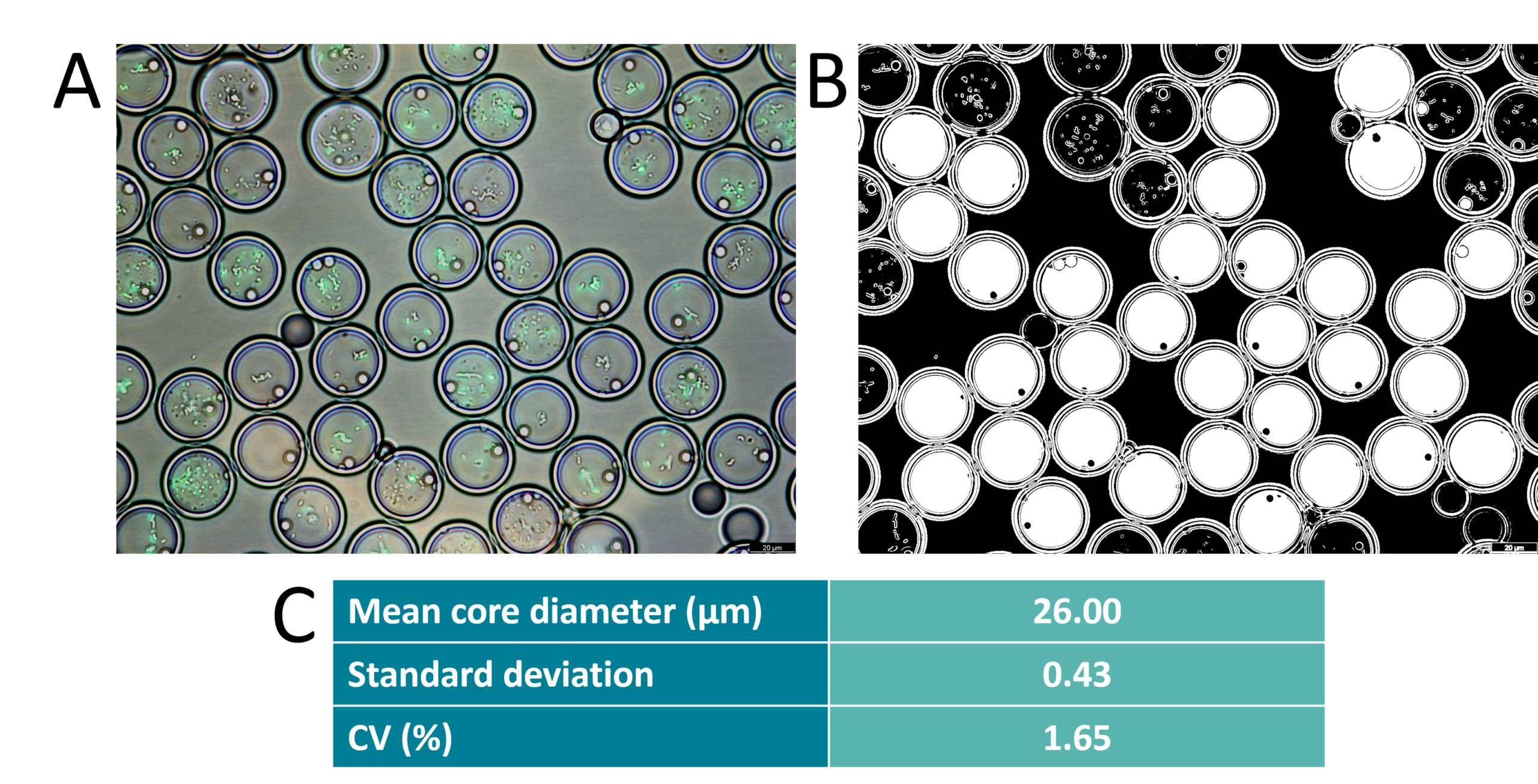
Mikroskopische Beobachtung und Analyse der fluoreszierende E-Coli enthaltenden Doppelemulsion mit (A) BF + GFP mikroskopischem Bildstapel, (B) dem Kernflächenbefund und (C) dem mittleren Kerndurchmesserwert mit der Standardabweichung; Skalenbalken = 20µm
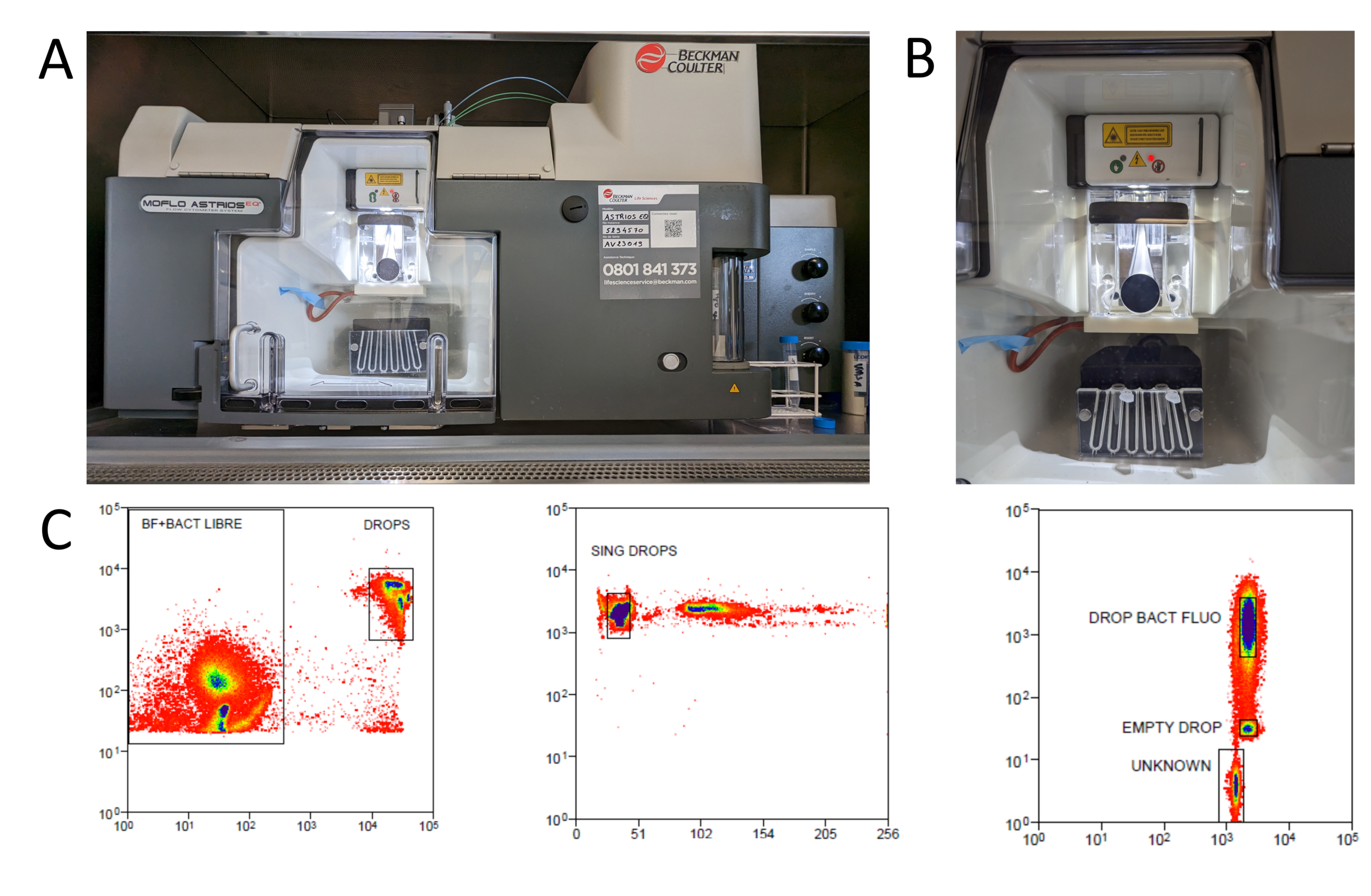
FACS-Maschine für die Sortierung (A) mit einem Zoom auf den Sortierbereich (B) und (C) Zytometrie-Analyse und Gating
Mikrofluidische Plattform für komplexe Emulsionen
Eine gebrauchsfertige Plattform für alle Arten von Emulsionen und Tröpfchen
Diese Plattform zur Herstellung komplexer Emulsionen ist ein schnelles und einfaches Screening-System zur Durchführung von Emulgierprozessen wie Einfach- und Doppelemulsionen. Sparen Sie Zeit mit einer integrierten, organisierten, sofort einsatzbereiten Plattform und erhalten Sie schnell monodisperse komplexe Emulsionen.

Mikrofluidische Plattform für komplexe Emulsionen
Merkmale der komplexen Emulsionsplattform:
- Sofortiger Beginn der Emulsionsproduktion: Das System ist ein vollständig ausgestattetes, montiertes und kontrolliertes Werkzeug zur Einrichtung komplexer Emulsions-, Mikropartikel- und Mikrokapselproduktionsprozesse.
- Ein ausgereiftes System: Vereinfachte Handhabung durch ein organisiertes System.
- Einfache Vorbereitung- und Reinigungsprozesse für mehr Robustheit.
- Spezielle Optik für optimierte Tröpfchenvisualisierung bei hohen Frequenzen und Halter für die Fehlersuche bei Luftblasen.
- Fluigent Präzision: Produzieren Sie robuste, hoch monodisperse Emulsionen mit druckbasierten Flussreglern von Fluigent und dem Raydrop.
Beispiele für Anwendungen
Verkapselung von mehreren Emulsionen in einem einzigen Tröpfchen
Die Verkapselung mehrerer Emulsionen in einer einzigen Hülle wurde durch die Verwendung von zwei Raydrop-Geräten in einer Reihe auf der komplexen Emulsionsproduktionsplattform demonstriert[2]. Durch die Abstimmung der Flussraten der Kernphase kann die Anzahl der verkapselten Kerne gesteuert werden.
Durch die Integration der Plattformstruktur „zwei Chips in einer Reihe“ mit einem Raydrop-Tropfengenerator für Doppelemulsionen ist es möglich, komplexere Emulsionen zu erzeugen. Dies schließt die Verkapselung mehrerer Doppelemulsionen in einem einzigen Tropfen ein. Diese vielversprechenden Ergebnisse könnten als synergistisches Verabreichungssystem oder als chemischer Mikroreaktor für inkompatible Wirkstoffe oder Chemikalien dienen.
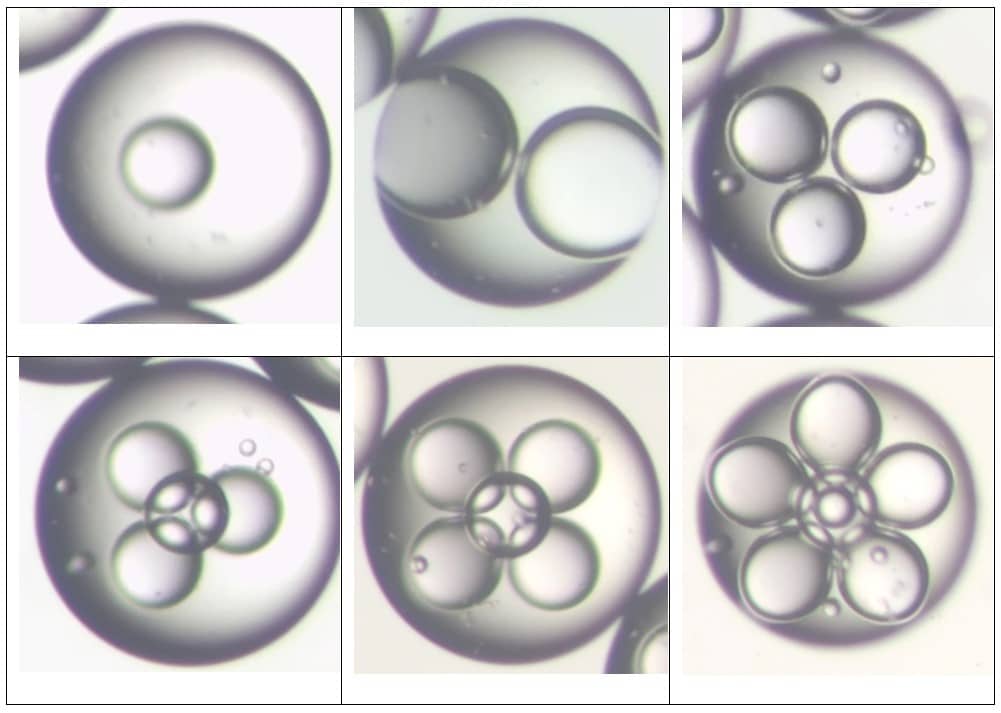
Bilder von Mehrfachemulsionen, die bei unterschiedlichen Flussraten
aufgenommen wurden, um die Anzahl der Kerne in einem einzelnen Tropfen zu variieren
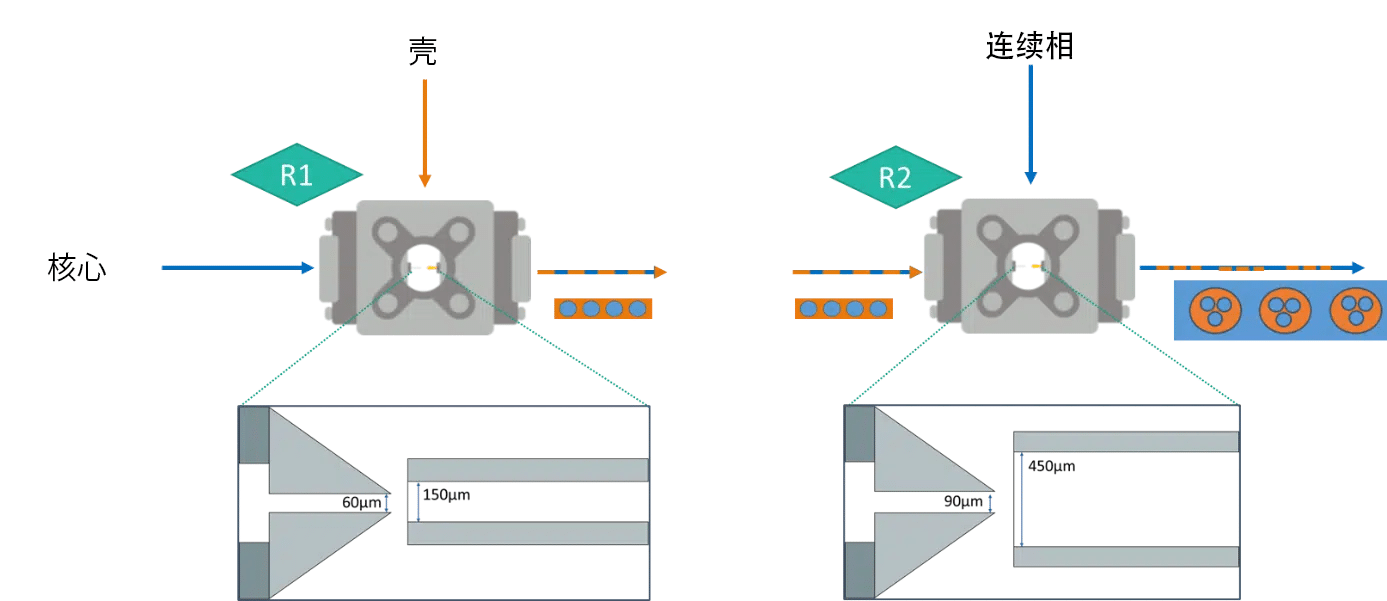
Zwei RayDrop in einer Reihe angeordnet
Mikrofluidische Packung
PLGA-Mikropartikel-Produktionspackung
Herstellung von monodispersen PLGA-Mikropartikeln
Die PLGA-Mikropartikel-Produktionsstation ist eine robuste, leistungsstarke Lösung zur Herstellung von Polymer-Mikropartikeln in homogener und vollständig kontrollierter Weise. Die Leistung des RayDrop-Tropfengenerators in Verbindung mit der Kombination von Poly(milch-co-glykolsäure) als Verkapselungspolymer und Ethylacetat als Lösungsmittel bietet eine biokompatible Lösung, die sowohl das Gefahrenrisiko als auch die Ausfällungszeit verringert.
Der RayDrop und seine Station eignen sich für biologische Anwendungen und bieten eine halbautomatische Lösung für eines der erfolgreichsten Arzneimittelverabreichungssysteme in Labors und Kliniken. Die Steuerung und Erzeugung von Tröpfchen ermöglicht eine hochgradig monodisperse, stabile und kontinuierliche Produktion im Vergleich zu Batch-Emulsionsverfahren.
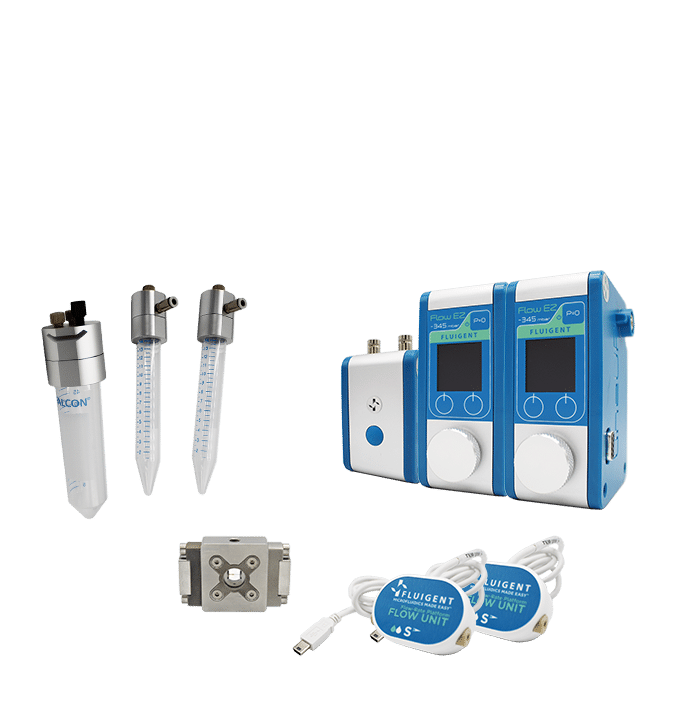
Merkmale des PLGA-Mikropartikel-Produktionspakets:
- Ein komplettes System: Mit dem PLGA-Pack erhalten Sie alle Komponenten, die Sie für die Herstellung von PLGA-Mikropartikeln benötigen.
- Eine technisch ausgereifte Lösung: Wir haben das Paket mit Druckreglern, mikrofluidischen Chips und Ventilen zusammengestellt, um Ihnen maximale Flexibilität in Bezug auf Tröpfchengröße und Generierungsrate zu bieten.
- Ein spezielles Protokoll: Es steht ein Protokoll zur Verfügung, das Sie beim Einrichten und Starten Ihrer Experimente unterstützt.
- Individuelle Anpassung möglich: Wir können das Standardpaket zur Herstellung von PLGA-Mikropartikeln an Ihre Bedürfnisse anpassen (Tröpfchengröße, Erzeugungsrate, Doppelemulsion).
Beispiele für Anwendungen
Die erfolgreiche Herstellung von PLGA-Mikropartikeln mit Durchmessern zwischen 15 und 50 µm wurde bereits nachgewiesen[3]. Im Vergleich zu anderen auf dem Markt erhältlichen Technologien ermöglicht das PLGA-Mikropartikel-Produktionspaket eine hohe Reproduzierbarkeit und eine deutlich erhöhte Monodispersität (CV 2%). Sie ermöglicht eine ununterbrochene, langfristige Produktion von PLGA-Mikropartikeln für den Einsatz in Untersuchungen.
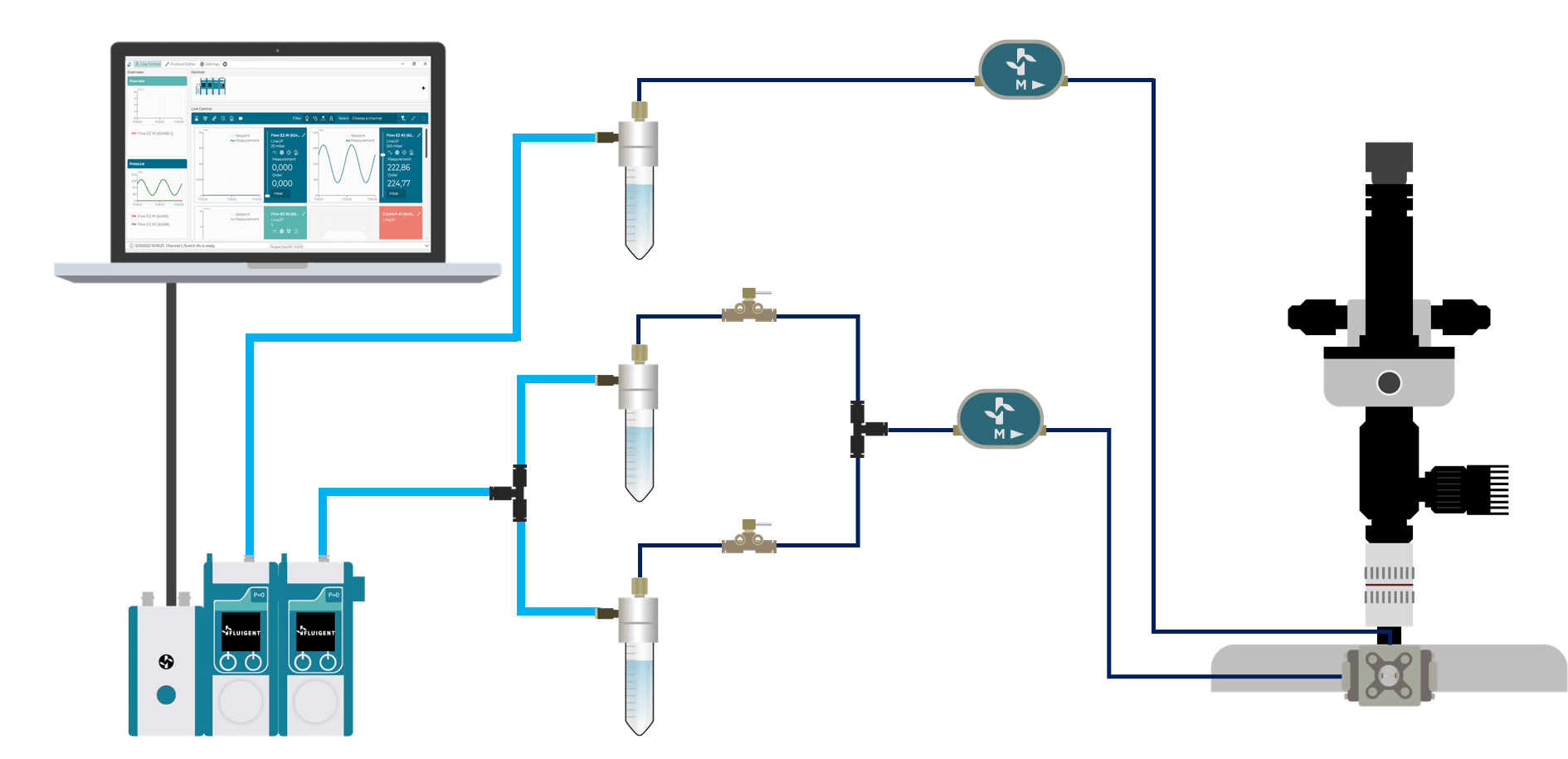
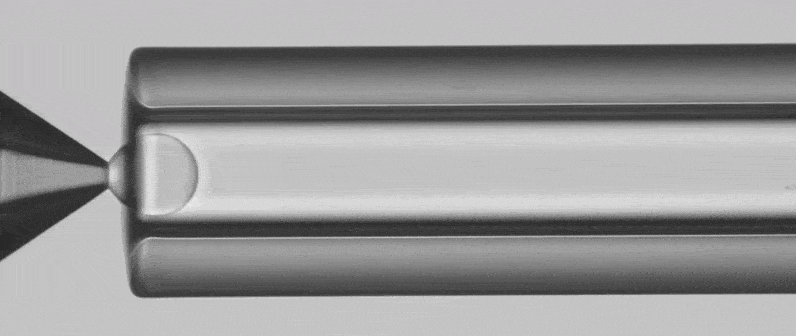
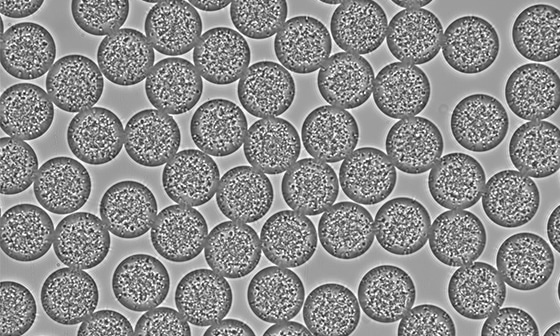
Herstellung von PLGA-Mikropartikeln mit RayDrop
Paket zur Erzeugung von Alginatpartikel
Ein System zur Herstellung monodisperser Alginatpartikel.
Das Fluigent Alginatpartikel Generation Pack ist ein robustes und komplettes System für die Herstellung hervorragender monodisperser Alginatpartikel. Das Generierungspaket ist flexibel, so dass die Alginatpartikel ihre Partikelgröße in Hunderten von Millisekunden ändern können, ohne die Produktion zu unterbrechen.
Das Generierungspaket wird von den mikrofluidischen LineUP-Pumpen von Fluigent und dem RayDrop-Gerät angetrieben, einer bahnbrechenden Technologie für die Herstellung hochwertiger Partikel und Perlen.
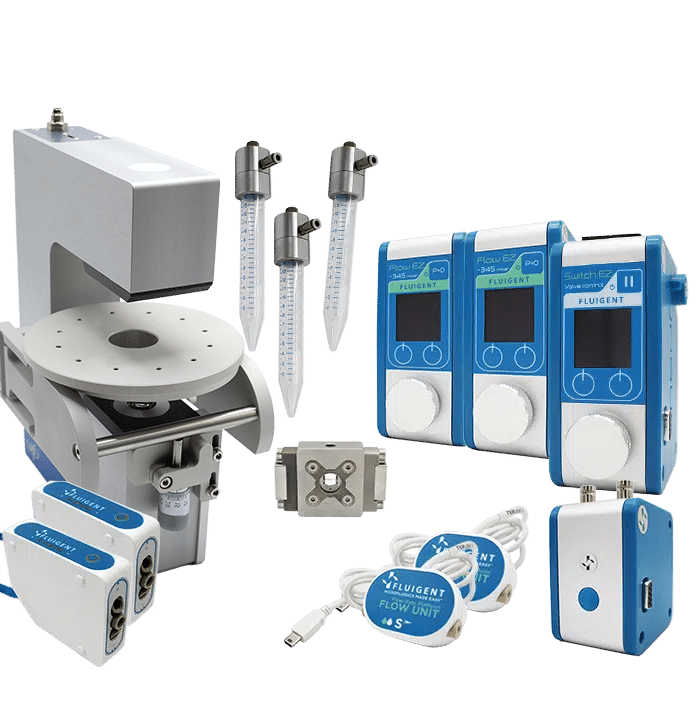
Merkmale von Alginatpartikel Generation Pack:
- Vollständiges System: Dieses Paket enthält alle Komponenten, die für die Herstellung von Alginatpartikel erforderlich sind.
- Ausgereifte Lösung: Das Paket wurde mit Druckreglern, mikrofluidischen Chips und Ventilen ausgestattet, die in Bezug auf die Tröpfchengröße und die Erzeugungsrate angepasst werden können.
- Spezielles Protokoll: Es steht ein Protokoll zur Verfügung, das Sie beim Einrichten und Starten Ihrer Experimente unterstützt.
- Anpassungen möglich: Wir können das Paket an Ihre Bedürfnisse anpassen (Tröpfchengröße, Erzeugungsrate).
Beispiele für Anwendungen
Alginatpartikel sind eines der am meisten untersuchten Materialien zur Verkapselung von Zellen, da sie biokompatibel, ungiftig, biologisch abbaubar und kostengünstig sind[4].
Alginatpartikel können mit dem RayDrop bei präziser Kontrolle der Tröpfchengröße erfolgreich hergestellt werden. Mit einer Alginatlösung in Wasser wurden Partikel mit einem Durchmesser von 95-160µm erzeugt.
Dieser Aufbau und dieses Protokoll können für die Verkapselung von Säugetierzellen, Bakterien und anderen Reagenzien in Alginatpartikel verwendet werden.
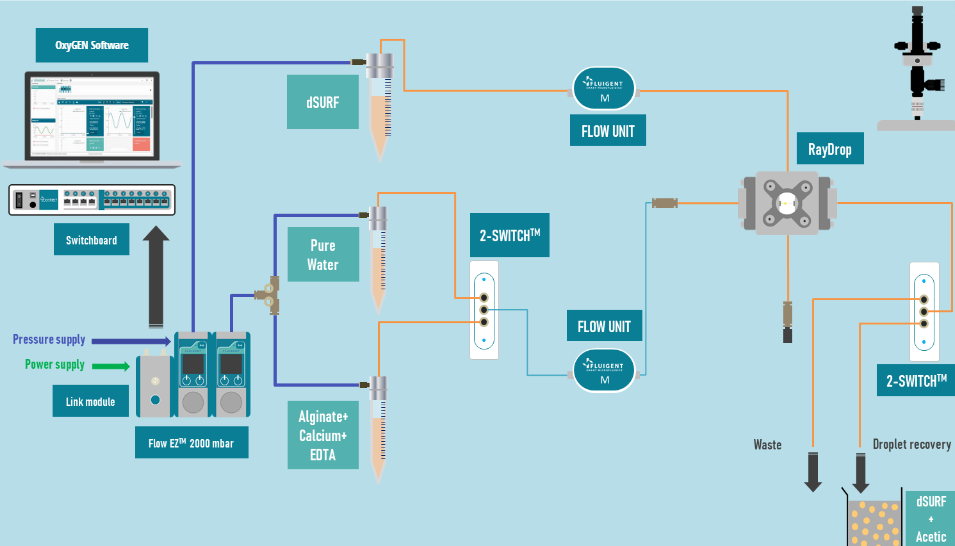

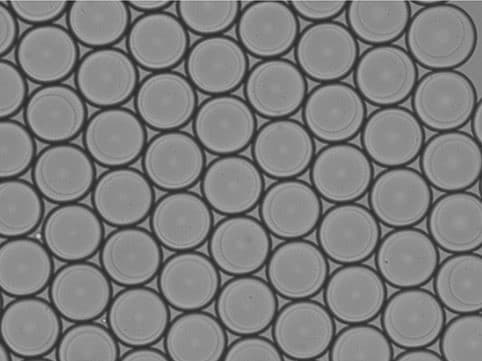
Verzahnte Perlenproduktion mit RayDrop
Microfluidic chips
PDMS Drop-seq chip for Drop-seq experiments
Drop-seq chip
Unser Drop-seq-Chip ist ein PDMS-Chip mit 22 operativen Designs einschließlich einer hydrophoben Silanbeschichtung.

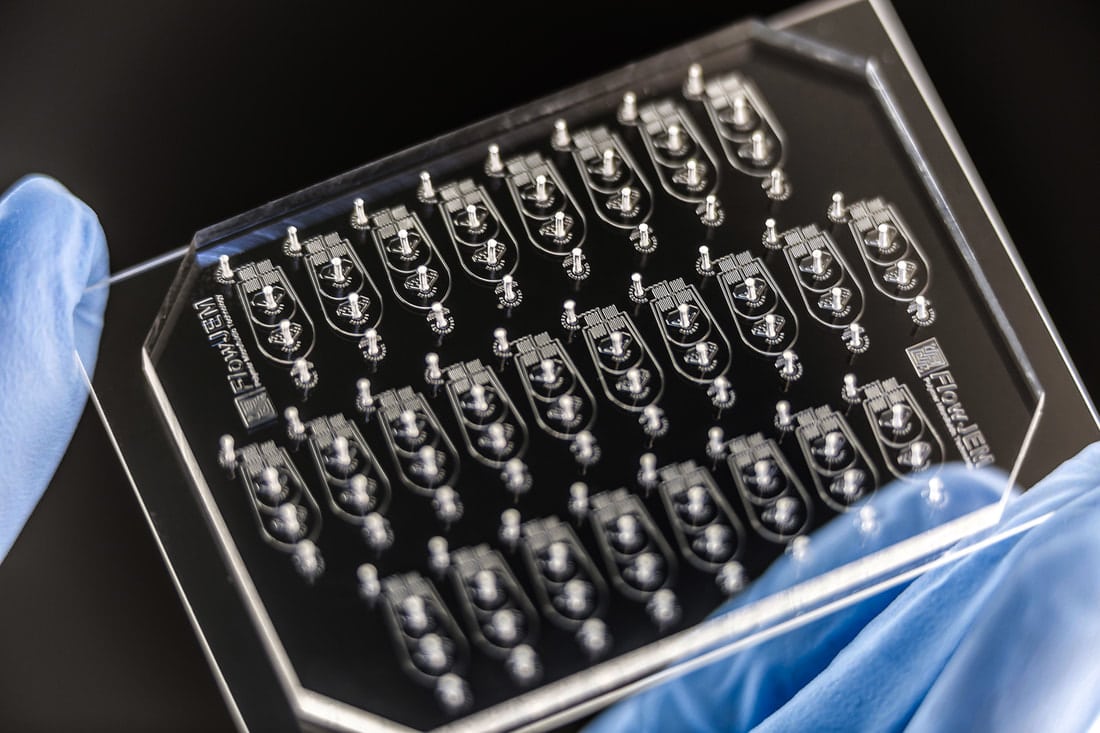
Merkmale des Drop-seq-Chips:
- peziell für Drop-seq: Jedes Droplet Generation Device basiert auf dem Design, das im neuesten Drop-seq-Protokoll des McCarroll-Labors empfohlen wird, um die besten Erfolgsaussichten zu gewährleisten.
- Mehr als 22 Experimente pro Chip: 22 Droplet Generation Devices pro Chip bieten ein optimales Preis-Leistungs-Verhältnis in einem langlebigen Chip. Wenn die Lebensdauer eines Geräts erschöpft ist, wechseln Sie einfach zum nächsten Gerät. Außerdem erstellt unser Drop-Seq-Chip schnell Bibliotheken, die für die high throughput bereit sind.
- Effiziente Produktion von Transkriptbibliotheken: Die Bibliotheken aus jeder Zelle werden mit einem eindeutigen Strichcode versehen, und es können praktisch über eine Million Zellen pro Experiment mit einem Strichcode versehen werden. Der Arbeitsablauf für die Bibliotheksgenerierung und das Barcoding ist schnell, einfach, robust und widerstandsfähig.
- Das überlegene Design fördert die optimale Durchmischung der Komponentenflüssigkeiten und minimiert so das Abscheren der Beads oder die vorzeitige Lyse von Zellen und die Freisetzung von mRNA.
Beispiele für Anwendungen
Identifizierung von Zellsubpopulationen
Eine der Hauptanwendungen des Drop-seq-Chips ist die Untersuchung von Zellpopulationen und die Identifizierung von Zellsubpopulationen. Durch die Analyse der transkriptomischen Profile einzelner Zellen können Forscher Zellen mit ähnlichen Genexpressionsmustern identifizieren und sie in Subpopulationen einordnen. Dies kann nützlich sein, um die Vielfalt und Funktion von Zellen in komplexen Geweben wie dem Gehirn oder dem Immunsystem zu verstehen.
Analyse der Zelldifferenzierung
Eine weitere Anwendung von Drop-seq ist die Untersuchung von Entwicklungsprozessen. Durch die Isolierung und Sequenzierung einzelner Zellen in verschiedenen Entwicklungsstadien können Forscher verstehen, wie sich die Genexpression im Laufe der Zeit verändert und wie sich Zellen in verschiedene Zelltypen differenzieren. Dies kann Aufschluss darüber geben, wie sich Organismen entwickeln und wie verschiedene Zelltypen gebildet werden.
Einfacher Chip zur Tropfenerzeugung EZ Drop
Eine vollständig angepasste Liquid-Handling-Lösung und eine Vielzahl von Zubehör machen Ihren Experimentierprozess so reibungslos und einfach wie möglich. Mit dem EZ Drop können Sie problemlos mikrofluidische Tropfen mit hoher Monodispersität und Stabilität herstellen, die präzise und genaue Experimente ermöglichen.
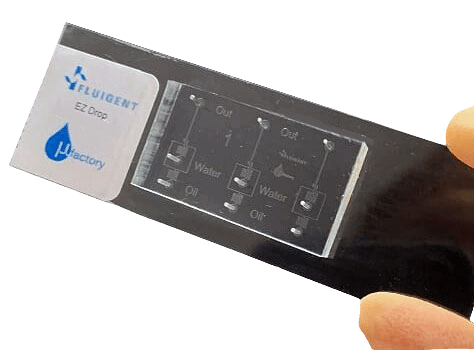
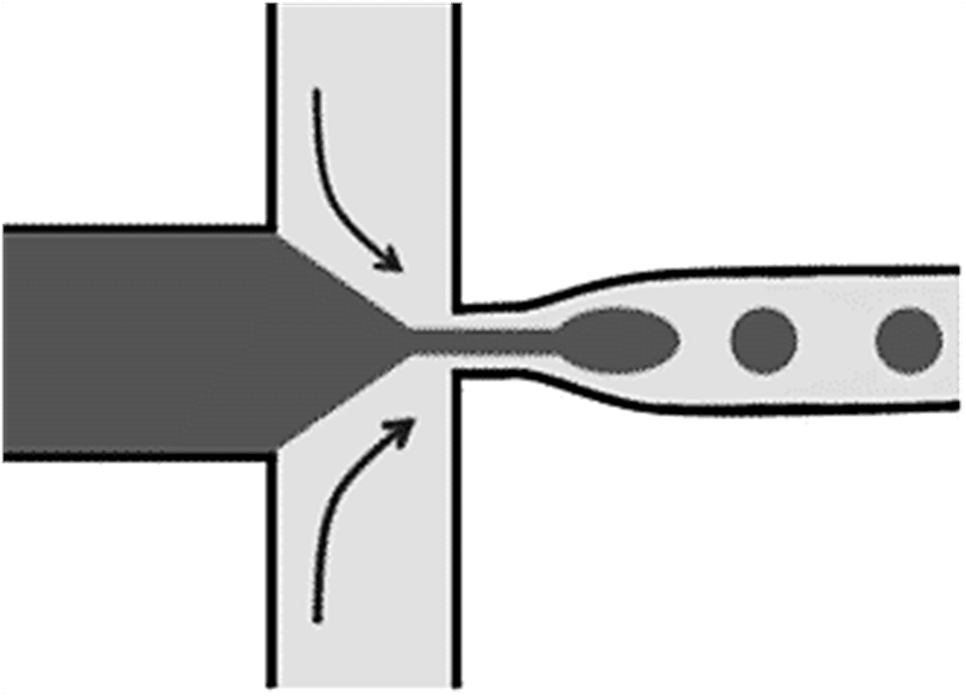
Merkmale von EZ Drop :
- Großer Bereich von Tropfenerzeugungsraten : Wasser-in-Öl-Tropfen mit bis zu 1 200 Hz
- Anpassbare Tropfengröße: Die Tropfengröße lässt sich durch die Steuerung der Flussrate leicht anpassen und ermöglicht so eine präzise Steuerung der erzeugten Tropfengröße. Es können Tropfen mit einer Größe von 20 µm bis 100 µm erzeugt werden.
- Ein benutzerfreundlicher Mikrofluidik-Chip: PDMS-Mikrofluidik-Chips mit Markierungen zur Bestimmung der Tropfengröße – Integrierter Widerstand zur Vermeidung von Rückfluss.
Beispiel für Anwendungen
Der EZ Drop Chip wurde verwendet, um die Verwendbarkeit von Tensiden für einen beispielhaften digitalen PCR-Test zu demonstrieren. [6] Die erzeugten Tropfen waren homogen in Form und Größe. Die Reproduzierbarkeit der Experimente wurde ebenfalls bestätigt. Die Tropfenenerzeugung mit identischen Parametern führt zu identischer Tropfengröße und -qualität.
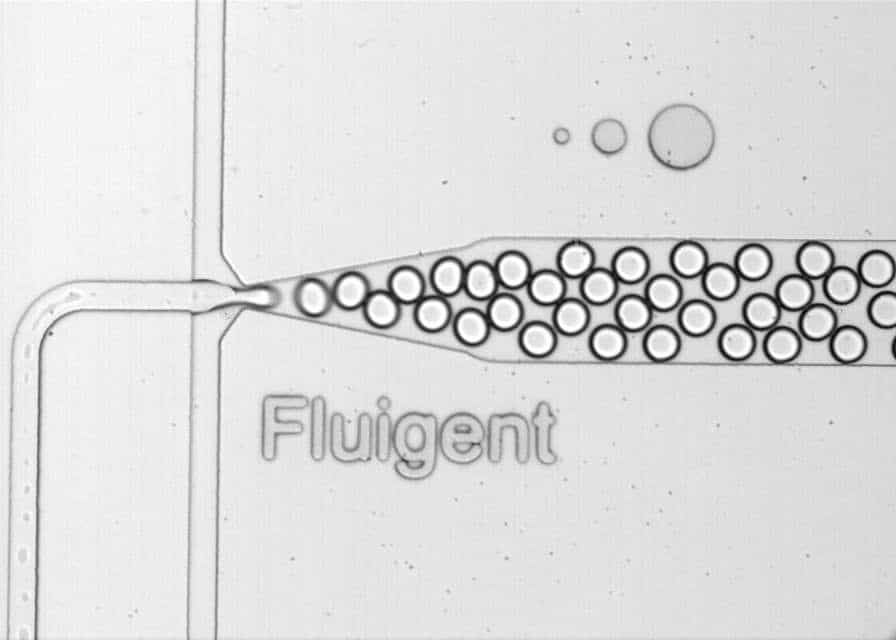
Prozess der Tropfenerzeugung.
Der Tropfengenerator arbeitet im Übergangsmodus zwischen Tropf- und Strahlbetrieb. Es sind keine signifikanten Unterschiede in der Betriebsweise sowie in den Tropfengrößen und der Größengleichmäßigkeit zu erkennen.
Referenzen
(1) Macosko, E. Z. et al. Highly parallel genome-wide expression profiling of individual cells using nanoliter droplets. Cell 161, 1202–1214 (2015).
